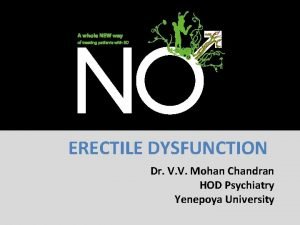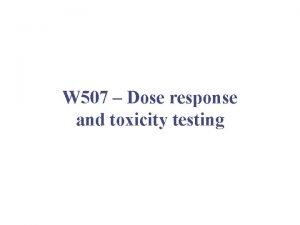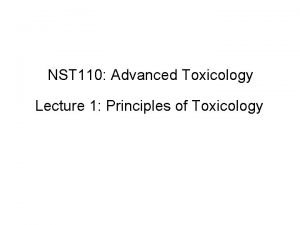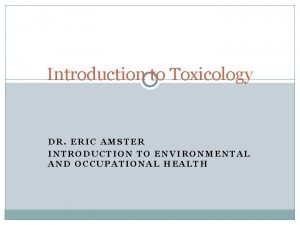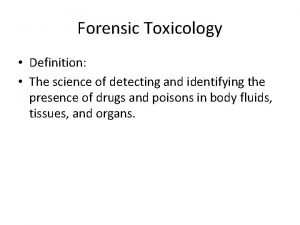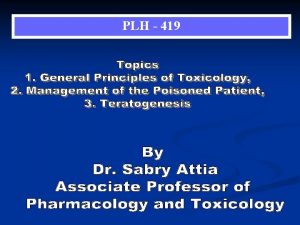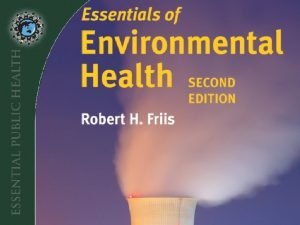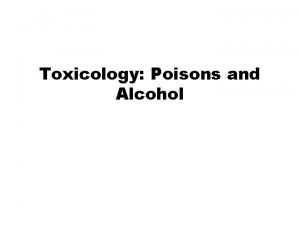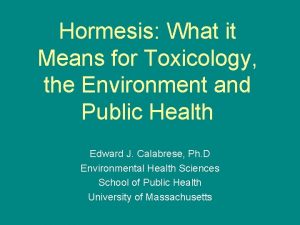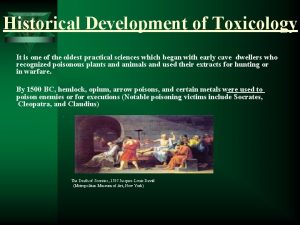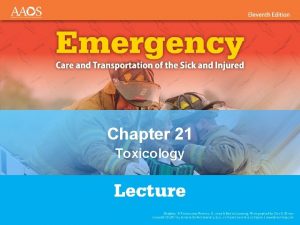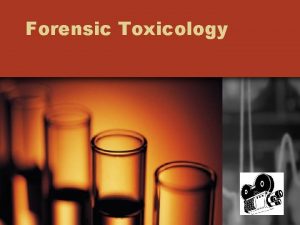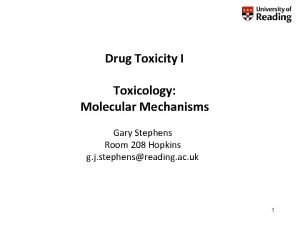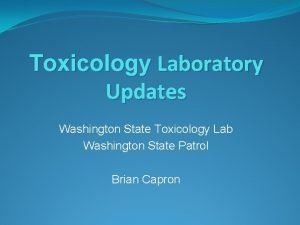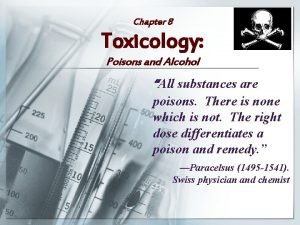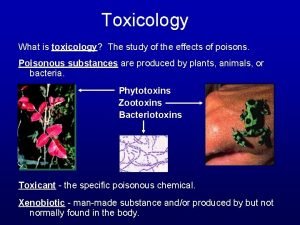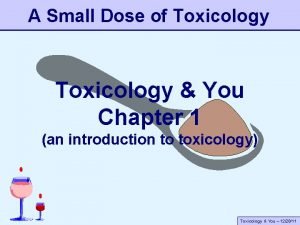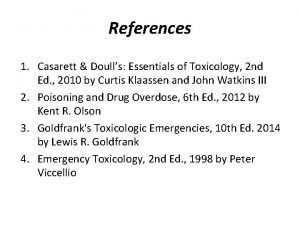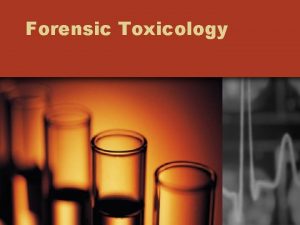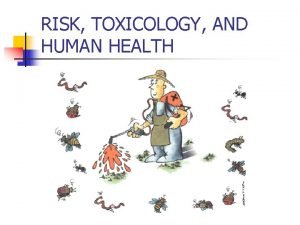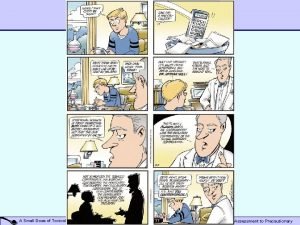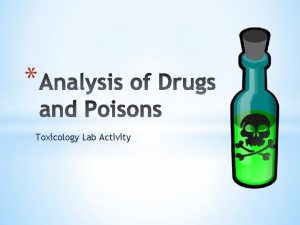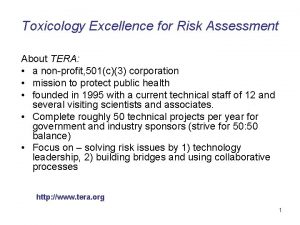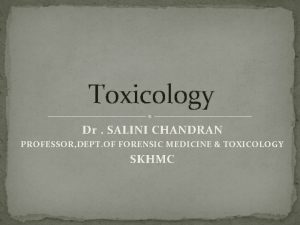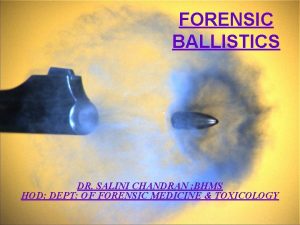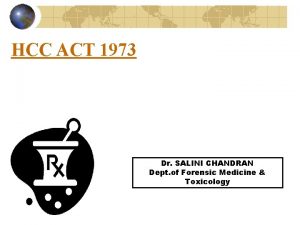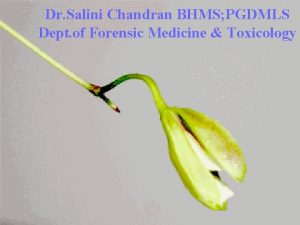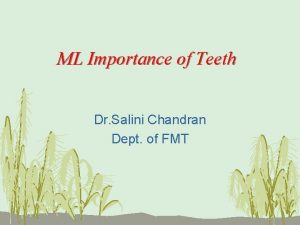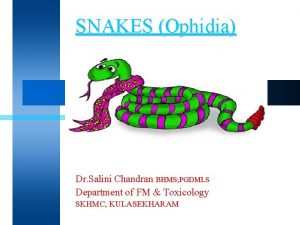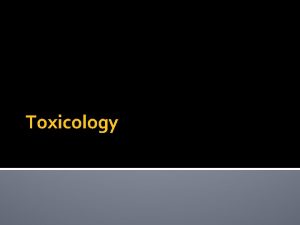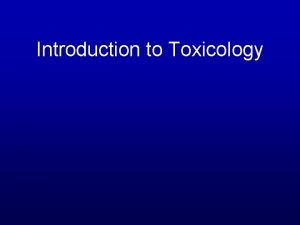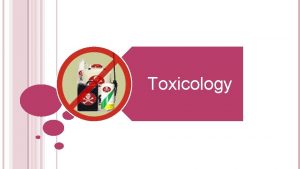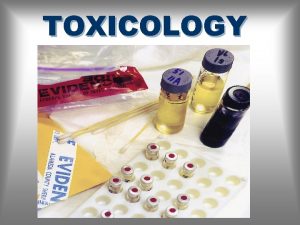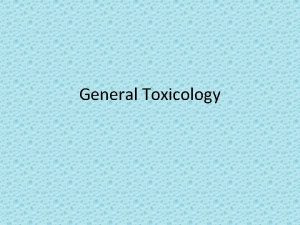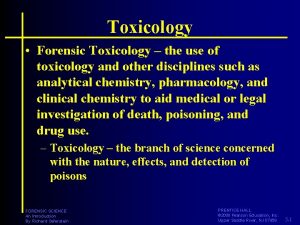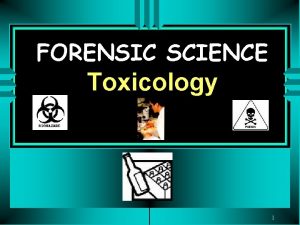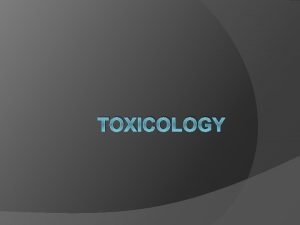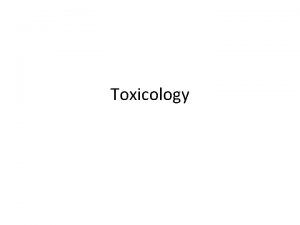Toxicology Dr SALINI CHANDRAN Toxicology Toxicology is the


















































































- Slides: 82

Toxicology Dr. SALINI CHANDRAN

Toxicology �Toxicology is the science dealing with properties, actions, toxicity, fatal dose, detection of, interpretation of the result of toxicological analysis and treatment of poisons � Forensic toxicology deals with the medico‐legal aspects of the harmful effects of chemicals on human beings �Clinical toxicology deals with diagnosis and treatment of human poisoning

poison �Poison is a substance (solid, liquid or gas), which if introduced in the living body, or brought into contact with any part thereof, will produce ill health or death, by its constitutional or local effects or both

Ideal Homicidal Poison �should be cheap and easily available � Should be colorless, odorless and tasteless � Capable of being administered with food materials without being detected �Should be highly toxic � Signs & symptoms should resemble a natural disease � Least Postmortem changes and not to be detected by any chemical tests �e. g. Fluorine and Thallium, but commonly used are Arsenic and Aconite

Ideal Suicidal Poison �Should be cheap and easily available � Should be tasteless or be of pleasant taste � Capable of being administered with food materials � Should be highly toxic � Should be capable of producing painless death �e. g. Opium and Barbiturates, but commonly used are Organophosphorus compounds and Endrin

Stupefying Poisons: Datura, Cannabis indica, Chloral Hydrate. Abortificient Poisons: Calotropis, Oleanders, Aconite, Croton, Semecarpus, Cantharides, Ergot, Lead, Arsenic, Mercury, and Potassium permanganate. Cattle Poisons: Abrus precatorius, Oleanders, Calotropis, Organophosphorus, Arsenic, Aconite, Strychnine, etc Arrow Poisons: Abrus, Croton, Aconite, Strychnine, Curare and Snake venom etc

Types of Poisoning �Acute Poisoning – large single dose – frequent smaller ‐ produces signs and symptoms fast �Chronic Poisoning – small doses over a period of time �Sub‐acute Poisoning – between acute and chronic �Fulminant Poisoning‐ massive dose‐death sudden due to shock , peripheral vascular failure

Routes of Absorption �Inhalation ‐ Fastest �Parenteral �Injections �Application on mucous memranes �Natural orifices �Intact skin

Diagnosis of Poisoning �Sudden onset of abdominal pain, nausea, vomiting, diarrhea and collapse (Arsenic) � Sudden onset of coma with constriction of pupils (Organophosphates) � Sudden onset of convulsions (Strychnine) �Sudden onset of delirium with dilated pupils. (Datura)

Diagnosis of Poisoning in the Dead � COLOR CHANGES on affected skin and mucous membrane. (black color in H 2 SO 4 & HCl, brown in Nitric acid) �PM STAINING may be Dark brown/yellow in Phosphorus, � Cherry red in CO, � Chocolate color in Nitrates, Nitrobenzene etc. �Cyanide – Brick Red

ODOUR from nose and mouth � GARLIC like (P, Arsine gas, Arsenic, organophosphates) � SWEETISH (Ethanol, Chloroform) �ACRID (Paraldehyde, Chloral hydrate) �BITTER ALMONDS – cyanide �HOSPITAL ODOUR‐ Phenol(carbolic acid) �BURNT ROPE – Cannabis(marijuana) �MUSTY (fishy) – zinc phosphide , Aluminium phosphide �ROTTEN EGG (H 2 S, Mercaptans)

POISONS RESISTING PUTREFACTION � 1. Phosphorus � 2. Arsenic � 3. Antimony � 4. Hyoscine � 5. Strychinne � 6. Nicotine

IPC sections � 274 – adulteration of drugs � 284 – Negligent conduct with respect to poisons � 324 – Causing hurt (including poisoning) � 326 – Causing grievous hurt by dangerous weapons or means (including poisoning) � 328 – causing hurt to commit an offence

Drugs causing pupillary changes Miosis Barbiturates Caffine Nicotine Opiates Organophosphates Mydriasis Alcohol Nystagmus Alcohol CO Barbiturates Cocaine Cyanide Datura

Drugs causing tachycardia �Alcohol �Datura �Nicotine Bradycardia Aconite Digitalis Opiates Organophophates

Duties of Medical Practitioner Private practitioners are bound to inform the police in case of homicidal poisoning � In suicidal and accidental‐If the person dies � If private practitioner is summoned by the investigative police officer, he is bound to divulge all information � Govt : medical practitioner – Has duty to inform all cases � Duty to arrange for Dying Declaration �

General Lines of Treatment �Airway , Breathing, Circulation, Depression of CNS(correction) Decontamination/Dextrose/Drugs � Removal of unabsorbed poisons: � Inhaled poisons: Fresh air � Injected poisons: Ligature application �Contact poisons: Immediate removal of clothing and washing thoroughly � Ingested poisons: Gastric Lavage

Gastrointestinal decontamination �Gastric Lavage (stomach wash) It is useful within 3 hrs of ingestion �salicylates, phenothiazymes, tricyclic antidepressants – (14 ‐ 16 hrs) � Ewald’s or Boas tube � Children – Ryle’s tube �Emesis

Gastric Lavage � 1 cm diameter & 1 ½ meter long � Has got lateral openings or 30‐ 40 French tube. � Middle portion has got a suction bulb �Other features are Mouth gag, 50 cm mark, etc. � 250 ml of Warm water is put over funnel of the tube and is taken out by the suction pump. � This washing is preserved for analysis � 1: 5000 Km. NO 4 sol. , 5% Na. HCO 3 sol. Or 4% Tannic acid 1 % sodium or potassium iodide is used for the lavage

Gastric Lavage �Patient position – left lateral , head dependent �Absolute CI is �Corrosive poisoning due to danger of perforation of stomach. (Exception: Carbolic Acid poisoning) �Convulsant poisons �Comatose patients �Volatile poisons �Esophageal varices �Hypothermia

Emesis: � It is useful within 3 hrs of ingestion �Done with ipecac syrup(30 ml) �Contraindications As in gastric lavage Severe heart disease Advanced Pregnancy

ADMINISTRATION OF ANTIDOTE �Activated Charcoal: Particles are small but with high absorptive capacity and it acts mechanically by adsorbing and retaining within its pores organic and some mineral poisons �Demulcents: These are substances which form a protective coating on the gastric mucous membrane and thus do not permit the poison to cause any damage �Examples include Milk, Starch, Egg white, Mineral oil, Milk of Magnesia, �Fats and oils should not be used for fat soluble poisons like, Kerosene, Phosphorus, OP compounds, DDT, Phenol, Acetone �Bulky Foods: They act as mechanical antidote to glass powder

Chemical Antidotes �They counteract the action of poison by forming harmless or insoluble compounds by oxidizing poisons �Common Salt: Decomposes Silver Nitrate by direct chemical action � Albumen: Precipitates Mercuric Chloride �Dialyzed Iron: Neutralize Arsenic poison

Physiological Antidotes: � These are substances which produce exactly the opposite actions to that of poison � e. g. atropine – PHYSOSTIGMINE �Strychnine ‐ BARBITURATES

Chelating agents �These agents act by forming stable and soluble complexes by the inner ring structure which can combine with the METALLIC POISONS �e. g. British Anti Lewisite (BAL) and �Ethylene diamine tetra‐acetic acid (EDTA)superior to BAL in Ars and Mercury �Penicillamine – maximum efficiency �Dmsa (succimer)superior in lead �DMPS �Desferroxamine‐ Acute iron poisoning

Universal Antidote � two parts activated charcoal, � one part tannic acid, � and one part magnesium oxide

ELIMINATION OF POISONS � URINARY ALKALIZATION: Aim for a Urinary p. H of 7. 5‐ 8. 5 Indications: poisoning with chlorpropamide, phenobarbitone, salicylates, phenoxy acetate herbicides � WHOLE BOWEL IRRIGATION � Magnesium citrate � Sodium sulphate 30 gm. � Sorbitol 50 ml 0 f 70% solution � polyethyleneglycol � Extracorporeal techniques: HEMODIALYSIS: � Multiple‐dose activated charcoal: This can increase elimination of some drugs by interrupting their enteroenteric & enterohepatic circulation � PERITONEAL DIALYSIS � CHARCOAL HAAEMOPERFUSION

Routine viscera to be preserved �Liver �Kidney �Stomach �Small intestine �Blood �Urine

COMA COCKTAIL �Dextrose – 100 ml of 50% solution �Thiamine – 100 mg �Naloxone ‐ 2 mg �UNIVERSAL ANTIDOTE

CORROSIVES �Corrosives are the poisons that fixes, destroys and corrodes tissues �Concentrated acids: • Mineral acids, eg. Sulphuric acid, Hcl, HNo 3 • �Organic acids, eg. Carbolic acid, Oxalic acid �Concentrated alkalies • eg. Caustic potash, Na. OH, KOH etc. �sulphuric acid ‐ (oil of vitriol)

CORROSIVES �Teeth chalky white – sulphuric acid �Perforation of stomach common – sulphuric acid �Stomach has consistency of wet blotting paper – sulphuric acid �Crowns of teeth yellow – nitric acid �xanthoproteic reaction – nitric acid �Pupils dilated �Fatal dose 10‐ 15 ml �HCl 15‐ 20 ml �Give nothing by mouth

Can give demulsants Do not neutralise with strong alkalies Do not give bicarbonate ‐ CO 2 gas ‐ risk of perforation Corroded areas brown or black, HCl ‐ gray VITRIOLAGE �Throwing of sulphuric acid to face – jealousy or revenge �Grievous hurt

OXALIC ACID �acid of sugar, salt of sorrel Colourless, transparent prismatic crystals, Natural constituent of plants eg spinach �FATAL DOSE : 15‐ 20 gm FATAL PERIOD: 1‐ 2 Hrs �Do not loose poisonous property even when diluted �VOMIT usually contains altered blood with mucous and HAS A COFFEE GROUND APPEARANCE �Hypocalcaemia �Signs of TETANY

OXALIC ACID �Fulminant poisoning �Uraemia‐oxalate crystals in renal tubules �Metabolic acidosis, VF �TREATMENT • Stomach wash– Ca lactate, Ca gluconate ( antidote is any prep of Ca • Ca gluconate 10%, 10 ml i. v

CARBOLIC ACID �CARBOLIC ACID ( phenol) • Colourless, prismatic, needle like crystals, with burning sweet taste with carbolic/ phenolic smell �FATAL DOSE : 10‐ 15 gm FATAL PERIOD: 03 TO 04 Hrs � S/S Poisoning is called CARBOLISM �Corroded mucosa appears whitish, lips , mouth and tongue corroded WHITE AND HARDENED �CARBOLURIA - Urine is colourless to slight green at first but turns green or even black on exposure to air. �Phenol is partly oxidised TO HYDROQUINONE AND PYROCATECHOL, The further oxidation of Hydroquinone and pyrocatechol in the urine is the cause of green coloration

CARBOLIC ACID �CHRONIC POISONING ( Phenol marasmus) �OOCHRONOSIS pigmentation of skin and cornea and cartilages �CAUSTIC ALKALIES �Effect esophagus> gastric mucosa � So STRICTURE FORMATION MUCH MORE COMMON with alkalies then with acids �OH‐ ion cause saponification of fats �LIQUIFACTIVE NECROSIS

CAUSTIC ALKALIES �FATAL DOSE: • Na. OH, KOH: 5 gm � Potassium carbonate: 18 gm • � Sodium carbonate: 30 gm � Ammonia: 5‐ 10 ml • � FATAL PERIOD: Usually 24 Hrs

Abrus Precatorius Indian Liquorice Active principle: – ABRIN ( toxic protein that disables ribosomes, inhibits protein synthesis, antigenic properties, hemolytic properties) ABRINE‐ an amino acid; haemagglutinin, ABRALIN‐ a glycoside F. D. : 1 SEED F. P. : 3 - 5 DAYS SUI’S – Needles – cattle poisoning, rarely for homicide. Resembles VIPERINE SNAKE BITE. TREATMENT : Anti abrin

RICINUS COMMUNIS (CASTOR, ARANDI) Active principle: • Toxalbumin RICIN, a water soluble glycoprotein F. D. : 10‐ 20 seeds F. P. : 3‐ 5 days Treatment: • Gastric lavage • Emetics and demulscents • symptomatic

Calotropis gigantea/ calotropis procera madar or akdo �Active principle: uscharin, calotoxin, calactin, calotropin (cardiac glycoside) and gigantin (contained in serum) �Medico‐ legal importance • �Madar juice is commonly used as an ABORTIFACIENT, • May be used for homicide , suicide or infanticide • ANIMAL POISON �ARTIFICIAL BRUISE � �ARROW POISON

DELIRIANT POISONS �Datura �Atropa belladonna �Hyoscyamus niger �Cannabis indica �Cocaine

Datura �Active principle contains alkaloids: � hyoscyamine � hyoscine or scopolamine �Traces of atropine

Datura � Earliest symptom: Bitter taste in mouth � Inhibition of salivation: Dryness of mouth and throat (dry as a bone) � � Difficulty in talking �� Dysphagia �� Unquenchable thirst � � Dilatation of cutaneous blood vessels �� Face is flushed (red as a beet) � � Pupils: Dilated � � Insensitive to light � Power of accommodation near vision paralyzed (Blind as a bat) � � Inhibition of sweat secretion & stimulation of heat regulating center: � Body temp. raised � � Skin dry and hot (hot as a hare) Vomiting , Giddiness, unsteady gait (drunken individual) � Initially restless and confused Later delirious, mutters indistinct words (mad as a wet hen)

Datura �FATAL DOSE & FATAL PERIOD �Seeds: 100 to 125 �Alkaloids: 60 mg (Adult) 4 mg (Children) �Death occurs within 24 hours �ML IMPORTANCE �ROAD POISON – stupefying persons for robbery, rape etc �Antidote - physostigmine

coccaine �a colorless , odorless, crystalline ALKALOID with better taste � prepared from the LEAVES of THE ERYTHROXYLON COCA PLANT �Crack. White lady, snow �Route of Administration Cocaine can be administered as a drug of abuse in the following ways � Cocaine hydrochloride Snorting (intranasal) Intravenous injection �ingestion

cocaine �Hyperthermia – cocaine fever �Amotivational syndrome �Chronic cocaine poisoning �Black tongue �COCAINE BUGS – MAGNAN’S BUGS –sensation of grains of sand under skin �SPEEDBALL – Combination OF COCAINE AND HEROIN - injected �BROMPTONS COCKTAIL‐mixture of cocaine + morphine (heroin) + chlorpromazine+alcohol, earlier used for pain management in terminal illnes like cancer.

Cannabis indica/sativa �Common Names : Indian hemp or cannabis sativa in India �THC – major psychoactive ingredient in the marijuana plant �cannibinol and cannbidiol also components but less present in plants �Names: marijuana, hashish, charas, bhang, ganja, sinsemilla �BHANG Least potent form Also called siddhi, patti, sabji � Prepared from dried leaves & fruit shoots

Cannabis indica/sativa �Mildest and contains 15% of active principle � MAJOON : Sweet prepared with bhang �GANJA Consists of flowering tops of the female plant It is mixed with tobacco and smoked in pipe �Contains active principle in conc. of 25% �MARIHUANA OR MARIJUANA Common names are pot, grass tea, Mary Jane �Smoked in pipe or rolled in cigarette called REEFERS OR WEED

Cannabis indica/sativa �CHARAS OR HASHISH � Resin exuding from leaves and stems � Dark green or brown color � Smoked with tobacco in a pipe ‘hookah’ �Active principle is in con of 25‐ 40% �It is the most powerful of all cannabis preparations

Cannabis indica/sativa �RUN AMOK : It is a psychotic disturbance caused by the continued use or even first time use of cannabis �It is characterized by a frenzied desire of the person to commit murders � He first kills a person against whom he may have real or imaginary enmity and then kills anyone who comes in his way until the homicidal tendency lasts. � �Then he may commit suicide or surrender himself.

Cannabis indica/sativa �TOLERANCE & PSYCHOLOGICAL DEPENDENCE � Develops when the drug is consumed over a prolonged period of time �MAJUN AND CHARAS used BY ROAD POISONers � HASHISH INSANITY (Chronic Poisoning) �Patient suffers from hallucinations and delusions of a persecuting nature �Chronic use reduces serum testosterone and sperm count

CARDIAC POISONS �Nicotiana Tabacum �Nereium Odorum �Cerebera Thevetia �Cerebera Odallum �Aconite �Digitalis

Nicotiana Tabacum �Alkaloids ‐ Nicotine , Nornicotine �Rapidly acting poison �FATAL DOSE : ‐ 50 -100 MG of Nicotine 50 -100 MG 15 TO 30 GM of crude tobacco 15 TO 30 GM : ‐ 5‐ 15 minutes 5‐ 15 �Brownish froth at mouth and nostrils �FATAL PERIOD

NERIUM ODORUM � Common oleander , pink oleander , rose laurel Contains cardiac glycosides Oleandrin Nerin Rosagenin Folinerin �FATAL DOSE : -15 -20 gm of the root; FATAL DOSE 5 -15 leaves �FATAL PERIOD: -20 -36 hrs

NERIUM ODORUM �Suicidal-decoction of root, leaves and seeds or paste �Homicide rare �Abortifacient- internally �Cattle poison-juice of the root is applied on a piece of cloth and �Inserted into the anus of the animal

CERBERA THEVETIA �Yellow oleander Cardiac glycosides �Thevetin �Thevetoxin �Nerifolin �Peruvoside �Ruvoside

CERBERA THEVETIA �FATAL DOSE : ‐ 8 -10 seeds; 15 -20 gms of root; 5 -10 leaves �FATAL PERIOD: -Uncertain �Suicide �Abortifacient �Cattle poison

CERBERA ODALLUM �ACTIVE PRINCIPLES : � Cerebrin �Cerebroside �Odollin �Odolotoxin �Thevetin �Cerapain

CERBERA ODALLUM �FATAL DOSE : -Kernel of one fruit �FATAL PERIOD: -1 -2 days or more PM APPEARANCES Those of asphyxia Congestion of organs with petechial hges TREATMENT �Stomach wash �Atropine �Correct hyperkalaemia

CERBERA ODALLUM �Suicide –mixed with jaggery or molasses �Homicide-powdered kernel added to alcohol �Bark leaves and milky juice as emetics and purgatives

ACONITE �Monk’s Hood, blue rocket �Contains alkaloids Aconitine �Pseudoaconitine �Mesoaconitine �Indaconitine �Bikhaconitine �Picraconitine �Aconine �Jesaconitine

ACONITE �FATAL DOSE -1 -2 gm root, 4 -5 mg of aconitine �FATAL PERIOD-2 -6 hrs �HIPPUS – Alternate contraction and dilatation of pupils �Mistaken for horseradish �Considered as ideal homicidal poison �With betel nut –to mask its taste-homicide �Abortifacient �Cattle poison �Arrow poison

CNS DEPRESSANTS �INEBRIANT – ALCOHOL �Following absorption, the concentration of alcohol in the blood reaches a maximum in about 45‐ 90 minutes after ingestion �Stage of Excitement (Blood level: 50‐ 150 mg%) �Stage of In‐coordination (Blood level: 150‐ 250 mg% �Stage of Coma (Blood level > 250 mg%) �Pupils are contracted but on stimulation of the person, e. g. by pinching or slapping. Causes them to dilate with slow return (MCEWAN’S SIGN).

ETHYL ALCOHOL � FATAL DOSE (non‐addict) : 150‐ 250 ml of absolute alcohol consumed in 1 hour. � Common clinical syndromes associated with chronic alcoholism � DELIRIUM TREMENS : acute organic brain syndrome, usually seen within 2‐ 4 days of complete absence from heavy alcohol drinking. � There is an acute attack of insanity in which there is: Clouding of consciousness with disorientation in time and space. Coarse muscular tremors of face, tongue and hands. Insomnia with reversal of sleep‐wake cycle and loss of memory. Psychomotor agitation, ataxia, uncontrollable fear and tendency to commit suicide/homicide/violent assault or cause damage to property

ETHYL ALCOHOL ACUTE ALCOHOLIC HALLUCINOSIS: 24 – 36 hrs after withdrawal Korsakoff’s psychosis often follows Wernicks’s encephalopthy so they are referred to as WERNICKEKORSAKOFF SYNDROME Cause: Severe, untreated thiamine deficiency, secondary to chronic alcohol abuse. WERNICKE’S ENCEPHALOPATHY : This is an acute reaction due to severe thiamine deficiency, the commonest cause being chronic alcohol abuse. MALLORY WEISS SYNDROME: Tears of mucosa of lower oesophagus with haemorrhaging

ETHYL ALCOHOL �SATURDAY NIGHT PALSY : from falling asleep with one's arm hanging over the arm rest of a chair, compressing the radial nerve. �DRUNKENNESS �MICTURITION SYNCOPE �ALCOHOLIC PALIMPSETS: Automatism after taking alcohol

METHYL ALCOHOL METHANOL ‐ alcohol dehydrogenase ‐ FORMALDEHYDE ‐ aldehyde dehydrogenase ‐ FORMIC ACID methanol itself not toxic. � Formaldehyde very toxic, but very rapidly metabolised to formic acid. �Formic acid responsible for the toxicity related to methanol ingestions

METHYL ALCOHOL �OPTIC NERVE BECOMES OEDEMATOUS �Sudden loss of vision or complete blindness due to optic neuritis may occur. �Permanent loss of vision �Treatment �ETHYL ALCOHOL

OPIUM � Dried juice of poppy (papaver somniferum) � morphine. codine, thebaine, papaverine. narcotine � HEROIN is a natural derivative(BROWN SUGAR) �COMA �PINPOINT PUPILS �Morphine-200 mg �Codine-800 mg �Antidote: NALOXONE �BODYPACKER SYNDROME �Test : Marquis test

ORGANOPHOSPHATES �INHIBITION OF ACETYL CHOLINESTERASE �Muscarinic effects: SLUDGE �White froth �CHROMOLACHRYORRHOEA – Red tears �Treatment: �Oximes – Pralidoxime �Atropine for Muscarinic effects �FATAL DOSE – Malathion - 1 gm

NUX VOMICA �Alkaloid‐ STRYCHNINE �Action on anterior horn cells �- on glycine �Opisthotonus �Trismus �Risus sardonicus

NUX VOMICA �Resembles TETANUS �Antidotes : Barbiturates �Rigor mortis early �Postmortem caloricity �ANTIDOTE: BARBITURATES �FATAL DOSE: 50 -100 mg, one crushed seed �FP – 1 -2 hrs �Test: Toad test

Asphyxiant poisons �CO 2 �Cyanide present in �bitter almonds �cherry, plum kernels. cassava(amygdalin) �apricot , peach kernels etc

HYDROCYANIC ACID( Hydrogen cyanide, Prussic Acid) �Colourless, highly volatile liquid �Odour of BITTER ALMONDS �Powerful protoplasmic poison �Interferes with action of CYTOCHRME OXIDASE �Histotoxic anoxia

�FATAL DOSE – 50 mg pure. HCN 2. 5 ml dilute HCN KCN ‐ 0. 2‐ 0. 5 gm Sodium cyanide‐. 15 gm �FATAL PERIOD‐ 2‐ 10 minutes �Antidotes : Amyl nitrate, sodium thiosulphate, sodium nitrate �BRICK/BRIGHT RED coloured postmortem staining �FROTH at mouth and nostrils �Test: LEE JONES TEST

CO �Anaemic anoxia �Interferes with cytochrome oxidase �COHB is formed �Treatment ‐ Hyperbaric oxygen �CHERRY RED Postmortem staining

Animal irritants �Snakes � COBRA & KRAIT –venom is NEUROTOXIC � VIPER – Venom is HAEMOLYTIC � SEASNAKE – Venom is MYOTOXIC � COBRA & KRAIT Cause of death – RESPIRATORY FAILURE � VIPER – HAEMORRHAGE AND SHOCK � SEA SNAKE –RENAL FAILURE �

Snakes �FATAL DOSE : - COBRA-12 mg RUSSEL’S VIPER 15 mg ECHIS-8 mg KRAIT-6 mg �FATAL PERIOD – COBRA AND KRAIT-1/2 -6 HRS -VIPER-1 -2 DAYS Treatment – POLYVALENT ANTISNAKE VENOM SERUM

cantharides �Cantharidin �Renal damage �SCORPION �Both neurotoxic and haemolytic venom

PHOSPHOROUS �Red and yellow �Yellow‐ translucent , waxy and luminous, toxic �Stored in water �Used in incendiary bombs �Fulminant poisoning �Acute: GARLICKY ODOUR OF BREATH

PHOSPHOROUS �Chronic – PHOSSY JAW – toothache , ulcerative stomatitis, necrosis , osteomyelitis of jaw �Jaundice �Yellow/Brown Postmortem staining �Fatal dose: 1 mg/kg of body weight(60‐ 120 mg)

BOTULISM �GI and CNS �Descending bilaterally symmetrical motor paralysis �Abducent & Occulomotor
 Arete e cocchi
Arete e cocchi Tetrafol plus for anxiety
Tetrafol plus for anxiety Leena chandran wadia
Leena chandran wadia Dr l sunil chandran
Dr l sunil chandran Chandran cyclothymia
Chandran cyclothymia Sudha chandran smoking
Sudha chandran smoking Mani chandran
Mani chandran Rani chandran
Rani chandran Anitha chandran
Anitha chandran ưu thế lai là gì
ưu thế lai là gì Tư thế ngồi viết
Tư thế ngồi viết Thẻ vin
Thẻ vin Thơ thất ngôn tứ tuyệt đường luật
Thơ thất ngôn tứ tuyệt đường luật Các châu lục và đại dương trên thế giới
Các châu lục và đại dương trên thế giới Từ ngữ thể hiện lòng nhân hậu
Từ ngữ thể hiện lòng nhân hậu Diễn thế sinh thái là
Diễn thế sinh thái là Thế nào là giọng cùng tên? *
Thế nào là giọng cùng tên? * Vẽ hình chiếu vuông góc của vật thể sau
Vẽ hình chiếu vuông góc của vật thể sau Phép trừ bù
Phép trừ bù Hát lên người ơi
Hát lên người ơi Tỉ lệ cơ thể trẻ em
Tỉ lệ cơ thể trẻ em Hổ sinh sản vào mùa nào
Hổ sinh sản vào mùa nào Lời thề hippocrates
Lời thề hippocrates đại từ thay thế
đại từ thay thế Quá trình desamine hóa có thể tạo ra
Quá trình desamine hóa có thể tạo ra Cong thức tính động năng
Cong thức tính động năng Hình ảnh bộ gõ cơ thể búng tay
Hình ảnh bộ gõ cơ thể búng tay Thế nào là mạng điện lắp đặt kiểu nổi
Thế nào là mạng điện lắp đặt kiểu nổi Dot
Dot Vẽ hình chiếu đứng bằng cạnh của vật thể
Vẽ hình chiếu đứng bằng cạnh của vật thể Phản ứng thế ankan
Phản ứng thế ankan Kể tên các môn thể thao
Kể tên các môn thể thao Chó sói
Chó sói Thiếu nhi thế giới liên hoan
Thiếu nhi thế giới liên hoan Khi nào hổ mẹ dạy hổ con săn mồi
Khi nào hổ mẹ dạy hổ con săn mồi điện thế nghỉ
điện thế nghỉ Thế nào là sự mỏi cơ
Thế nào là sự mỏi cơ Một số thể thơ truyền thống
Một số thể thơ truyền thống Trời xanh đây là của chúng ta thể thơ
Trời xanh đây là của chúng ta thể thơ Lp html
Lp html Số nguyên tố là số gì
Số nguyên tố là số gì Phối cảnh
Phối cảnh Các châu lục và đại dương trên thế giới
Các châu lục và đại dương trên thế giới Thế nào là hệ số cao nhất
Thế nào là hệ số cao nhất Chụp phim tư thế worms-breton
Chụp phim tư thế worms-breton Hệ hô hấp
Hệ hô hấp Tư thế ngồi viết
Tư thế ngồi viết đặc điểm cơ thể của người tối cổ
đặc điểm cơ thể của người tối cổ Cái miệng bé xinh thế chỉ nói điều hay thôi
Cái miệng bé xinh thế chỉ nói điều hay thôi Mật thư tọa độ 5x5
Mật thư tọa độ 5x5 Bổ thể
Bổ thể W 507
W 507 Ld50 examples
Ld50 examples Toxicology
Toxicology Definition of forensic toxicology
Definition of forensic toxicology Drug identification and toxicology
Drug identification and toxicology Toxicology defination
Toxicology defination Toxicology definition
Toxicology definition Important dates in forensic science
Important dates in forensic science Toxicology effects
Toxicology effects Hormesis ne demek
Hormesis ne demek Examples of toxicology
Examples of toxicology Toxicology management
Toxicology management Environmental toxicology definition
Environmental toxicology definition Chapter 21 toxicology
Chapter 21 toxicology Which is more toxic
Which is more toxic Toxicology and applied pharmacology
Toxicology and applied pharmacology Reinsch test
Reinsch test Food safety and toxicology
Food safety and toxicology Therapeutic index
Therapeutic index Washington state toxicology lab
Washington state toxicology lab Chapter 8 toxicology poisons and alcohol
Chapter 8 toxicology poisons and alcohol Toxicology terms
Toxicology terms A small dose of toxicology
A small dose of toxicology Toxicology effects
Toxicology effects Annual review of pharmacology and toxicology
Annual review of pharmacology and toxicology Nc medical examiner and coroner guidelines
Nc medical examiner and coroner guidelines A breath test reflects the alcohol concentration where?
A breath test reflects the alcohol concentration where? Forensic toxicology vocabulary
Forensic toxicology vocabulary Toxicology
Toxicology Toxicology types
Toxicology types Forensic toxicology lab activity
Forensic toxicology lab activity Tera toxicology
Tera toxicology

